Electrolux EKC60752 User Manual

user manual
Cooker
EKC60752


Welcome to the world of Electrolux
You've chosen a first class product from Electrolux, which hopefully will provide you with lots of pleasure in the future.
Electrolux ambition is to offer a wide variety of quality products that would make your life even more comfortable. You can look at some examples on the cover in this manual. But now it's time to study this manual and start using and enjoying the benefits from your new machine. We promise that it'll make your life a little easier. Good luck!
2

Contents |
|
Safety ..................................................................................... |
4 |
Installation ............................................................................. |
6 |
Changing plinth height............................................. |
6 |
Adjusting the level .................................................... |
7 |
Anti-tip guard .......................................................... |
8 |
Electrical connections............................................... |
9 |
Base trim ................................................................. |
9 |
Safety functions .................................................................. |
10 |
Child safety features ............................................. |
10 |
Function lock........................................................... |
10 |
The cooling fan....................................................... |
11 |
The door lock.......................................................... |
11 |
Description of product ................................................... |
12 |
The cooker ............................................................. |
12 |
The oven ................................................................ |
12 |
Before using for the first time ........................................ |
13 |
Setting the clock .................................................... |
13 |
Heat the oven emty............................................... |
14 |
Removable telescopic runners ............................. |
15 |
Using the ceramic hob...................................................... |
17 |
Touch panel ........................................................... |
22 |
Touch panel functions .......................................... |
23 |
Timer ...................................................................... |
28 |
Automatic safety switch-off .................................. |
28 |
Signal clock ............................................................. |
30 |
Locking/unlocking the touch area ....................... |
31 |
Using the oven.................................................................... |
32 |
The oven functions................................................. |
32 |
Oven display .......................................................... |
33 |
Choice of oven functions ...................................... |
34 |
Other functions ..................................................... |
40 |
Oven safety switch-off .......................................... |
40 |
Practical use............................................................ |
43 |
Cleaning and care .............................................................. |
50 |
Cleaning the cooker ............................................... |
50 |
Cleaning the ceramic glass plate ......................... |
51 |
Cleaning the oven ................................................. |
53 |
Technical data .................................................................... |
61 |
European Guarantee ............................................. |
62 |
Practical advice and tips ................................................... |
64 |
Problems and remedies.................................................... |
66 |
Disposal................................................................................ |
67 |
3

Safety
Cooker development has progressed rapidly. You cannot always use your new cooker in the same way as your old one. For this reason, you should read the instructions carefully and familiarise yourself with your new cooker and what it can do. The cooker is intended for normal household use. Please let us know if you have views or questions about your cooker and its use. You can find our address and telephone number in the “Service” chapter.
Text marked with a WARNING TRIANGLE concerns safety. READ THIS TEXT VERY
CAREFULLY, so that you do not injure yourself or others, or damage the cooker.
Unpacking
Check that the cooker is in perfect condition and not damaged. You must notify the dealer immediately of any damage that has occurred during transport. For direct deliveries, any transport damage must be notified to Customer Services within seven days according to the freight note.
The packaging can be recycled. Contact your local authority if you do not know where you can deposit it.
Do not forget to remove packing material from inside the oven before it is used.
Installation
Any work required on the cooker must be carried out by a QUALIFIED EXPERT. Any work carried out by non-qualified people can mean poorer cooker performance and result in personal injury and/or damage to property.
For cookers with a plug: Make sure that the plug is completely pushed into the mains socket.
The cooker is heavy. Edges and corners with which you do not normally come into contact, can be sharp. Use gloves when moving the cooker.
THE ANTI-TIP GUARD must be fitted so
that you avoid the cooker tipping when subjected to abnormal loading.
IMPORTANT! Do not place the cooker on an extra plinth or other heightincreasing unit. This means more risk that the cooker will tip over!
Children and the cooker
Children are by nature curious and interested in most things, even cookers. In the interests of safety, we should like to mention a few things that you should think about if you have children or children come to visit:
There must be a clear surface of at least 40 cm (16") on both sides of the cooker.
If you have a HEATING PLATE GUARD for
your cooker, then this must be fitted. THE DOOR LOCK must also function properly.
Never allow children to use the bladescraper.
Let children help you at the cooker, but teach them that pots and pans, hobs and ovens become very hot and retain heat for some time after use. TOUCHING
THEM CAN RESULT IN BURNS.
How to use
The appliance get hot during use. Do not touch the hob or the heatingelements inside the oven when the appliance is in use. Never use a cracked ceramic glass plate. Liquids could, if they boil over, or during cleaning, penetrate down into the live electrical components. Switch off the
4

power supply to the cooker and contact Service for repairs.
Never place metal objects such as lids, knives and spoons on the hob. They become hot if a heating zone is switched on by mistake.
Never leave a deep fat fryer, melting fat, paraffin or other easily flammable substance unattended. In the event of fire, turn off the cooker knobs and switch off
the fan. EXTINGUISH THE FIRE WITH A POT
LID, never use water.
Use only pans intended for use with an induction hob or oven.
Check the bottoms of pots and pans. Pans which bulge outwards tend to swivel easily on the ceramic glass hob.
Check that the cooker is switched off when not in use. All the knobs should be turned to zero.
Warning! Alcohol and similar substances, which can form explosive gases, or other substances that can cause a fire or explosion must not be used in the oven.
The ceramic glass plate must be used with the greatest care. For example, flaming with brandy or other forms of alcohol can result in traces of fat in the fan igniting and causing serious fires. Similarly, flames and burning fat spills can cause injury to people.
Do not keep chemicals or cleaning agents in the storage drawer.
Cleaning
Keep the ceramic glass hob and oven clean. Fat and spilled material can cause much smoke when heated and are also a possible fire hazard.
Immediately after use (while the plate is still hot) clean with the blade scraper to remove sugar and spills with a high sugar content, such as marmalade, and also any melted plastic or foil, in order to avoid
damage to the hob. Be careful, the blade scraper is extremely sharp.
Maintenance and service
Turn all knobs to zero before replacing a defective oven light bulb.
Service and repairs should only be carried out by a repair company approved by the supplier. Use only genuine spare parts.
At the end of the appliances life
The symbol  on the product or on its packaging indicates that this product may not be treated as household waste. Instead it shall be handed over to the applicable collection point for the recycling of electrical and electronic equipment.
on the product or on its packaging indicates that this product may not be treated as household waste. Instead it shall be handed over to the applicable collection point for the recycling of electrical and electronic equipment.
By ensuring this product is disposed of correctly, you will help prevent potential negative consequences for the environment and human health, which could otherwise be caused by inappropriate waste handling of this product.
For more detailed information about recycling of this product, please contact your local city office, your household waste disposal service or the shop where you purchased the product.
5

Installation
Any work required on the cooker must be carried out by a QUALIFIED EXPERT. The cooker is heavy. Edges and corners, with which you do not normally come into contact, can be sharp. USE GLOVES WHEN MOVING
THE COOKER.
When delivered, the cooker is adjusted to a bench height of 900 mm (35.4"). The cooker has a telescopic plinth. You can change the height so that the cooker suits a bench height from 848 mm (33.4") up to 933 mm (36.7").
Take care when positioning the cooker that you do not block the ventilation outlets (behind the cooker and at the top behind the hood), the cooker must not be pushed in under a tiled edge or similar.
The cooker must have a clearance on both sides (see Safety).
Make sure that the cooker cable does not get crushed when moving the cooker.
6
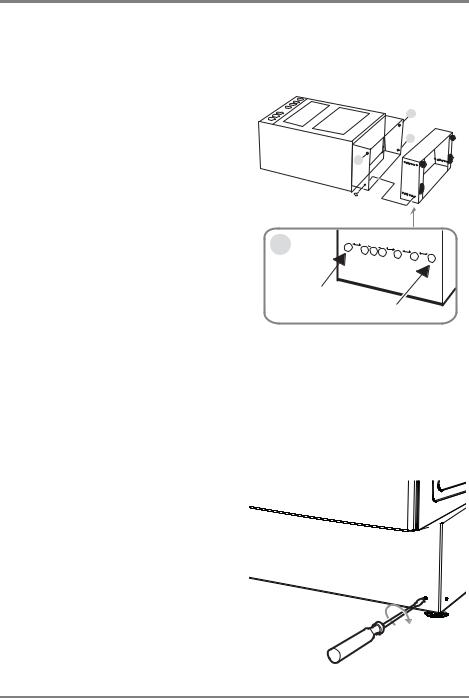
Adjusting the height of the base
If you wish to adjust the height, please read the following points before you start.
1 Lay down the cooker gently
(SEE ILLUSTRATION). Use, for example, |
|
|
|
|
|
|
|
|
the polystyrene from the packaging |
|
|
|
|
|
A |
|
|
|
|
|
|
|
|
|
||
between the cooker and the floor as |
|
|
|
|
|
A |
|
|
protection. Remember to locate a |
|
|
|
|
|
|
||
|
|
|
|
|
|
|
||
protective layer under the lower rear |
|
A |
|
|
|
|
|
|
corners of the cooker sides to protect |
|
|
|
|
A |
|
|
|
the floor. |
|
|
|
|
|
|
|
|
2 Unscrew the screws A (4 SCREWS, SEE |
|
|
|
|
|
|
|
|
ILLUSTRATION). Pull out the inner base |
|
|
|
|
|
|
|
|
slightly if you only wish to change the |
A |
14 |
|
|
|
|
|
|
height. Pull the brackets on which the |
7 |
7 |
14 |
14 |
14 |
|||
|
||||||||
|
|
|
|
|
|
|||
wheels and feet are fitted. NOTE! Be |
|
|
|
|
|
|
|
|
careful, there are sharp edges under the |
|
|
|
|
|
|
|
|
cooker. |
|
920 |
|
|
|
|
|
|
3 Screw in the screws again A in one of |
|
|
|
850 |
|
|||
|
|
|
|
|
||||
the holes for a bench height of 850 to |
|
|
|
|
|
|||
920 mm (33.4" to 36.2"). The distance between the holes varies between
7 mm (0.28") and 14 mm (0.51") (see illustration a).
4Lift the cooker upright and connect it up to the mains. Push the cooker back into position and make sure that it is absolutely level before fitting the safety equipment.
Horizontal adjustment
The cooker must be level so that, for example, fat spreads evenly in the frying pan. Place a spirit level or a frying pan containing water on the ceramic glass plate when you want to check whether the cooker is level.
If necessary, from the front of the plinth, you can adjust the cooker wheels and feet by 15 mm (0.6"). Use a screwdriver to adjust the rear wheels and a Polygrip for the front feet.
7
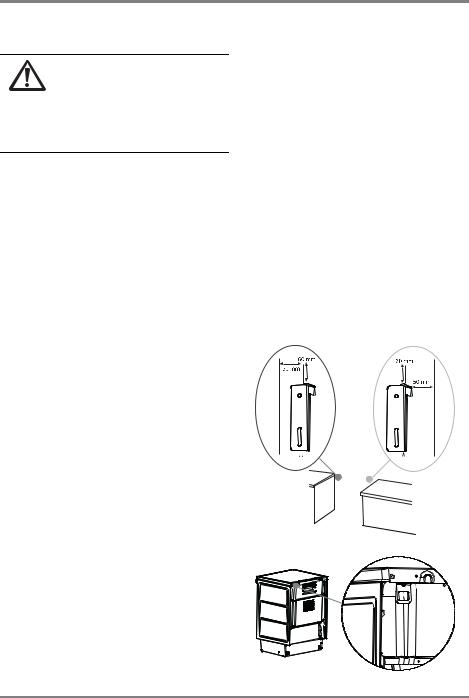
The anti-tip guard
The anti-tip guard must be fitted to prevent the cooker from tipping over with abnormal loads.
The anti-tip guard only works when the cooker has been pushed into place.
HOW YOU FIX THE ANTI-TIP GUARD
TO THE COOKER:
1Before fitting the anti-tip guard, make sure that the cooker has been adjusted to the correct height and is standing level (see page 7).
2The attachment (B) is fitted to the left side when delivered. Measure out where the anti-tip guard (A) is to be located, 60 mm (2.4") down from the edge of the ceramic glass plate and 50 mm (2.0") from the wall(cupboard). Screw it firmly into solid material or use suitable reinforcement. The entire anti-tip guard (A+B) can also be located on the right-hand side (SEE FIG. 1).
Make sure that the surface behind the cooker is smooth. If there are tiles or a moulding behind the edge of the ceramic glass plate then there must be a space with the same dimension between the anti-tip guard and
the wall. This is so that the antitip guard is firmly attached to the cooker and functions correctly.
Check that the anti-tip guard projects at least 20 mm (0.8") into the hole in the back of the cooker (B) when the cooker is pushed in (SEE FIG. 2).
NOTE! If the space between the bench cupboards is greater than the width of the cooker, then you must adjust the side measurement if you want to centre the cooker..
1
2
8

Electrical connections
Any work required on the cooker must be carried out by a QUALIFIED EXPERT. Any work carried out by non-qualified people can mean poorer cooker performance and result in personal injury and/or damage to property.
The electrical installation is to include a device whereby it is possible to separate all the poles of the equipment from the power supply, with a contact opening of at least
3 mm.
This requirement must be satisfied for safety reasons.
The connected rating and voltage are shown on the data plate. There is a wiring diagram on the back of the cooker.
Decor plinth (optional accessory)
NOTE! Take due care when fitting the base trim to the cooker. Edges with which you do not normally come into contact with can be sharp.
NOTE! ONLY FITS COOKERS WITH A HEIGHT
OF 900 MM (35.5").
Remove the protective plastic before use.
1 Remove the drawer from the cooker by lifting it diagonally upwards and then pulling it all the way out.
2 Fit the base trim by pressing it firmly onto the base (snap fastener, no tools needed).
3 Re-fit the storage drawer.
Bild 5
9
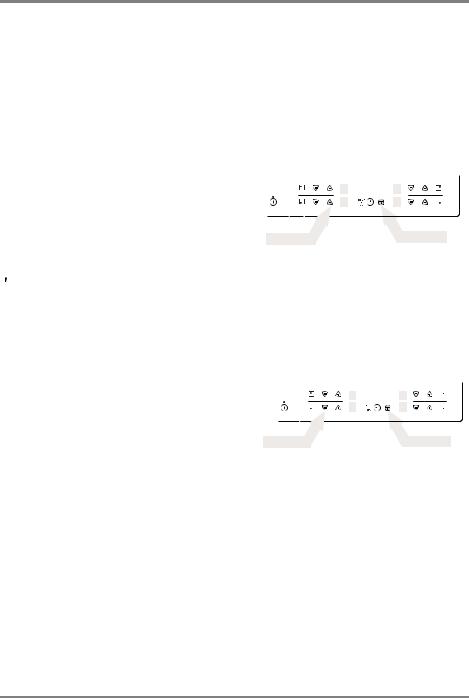
Safety features
Function lock
As security to prevent unauthorised use of the hob.
ENGAGING THE FUNCTION LOCK
1. Press the On/Off button  .
.
2. Press until a signal sounds  .
.
3. Then press an optional symbol  .
.
The function lock is now engaged.
 is shown in the display if the hob turns on. SAFE is shown in the ovendisplay if the oven turns on.
is shown in the display if the hob turns on. SAFE is shown in the ovendisplay if the oven turns on.
DISENGAGING THE FUNCTION LOCK
1. Press the On/Off button  .
.
2. Press until a signal sounds  .
.
3. Then press an optional symbol  .
.
The display goes out and the function lock is disengaged. The hob is automatically switched off after a few seconds.
10
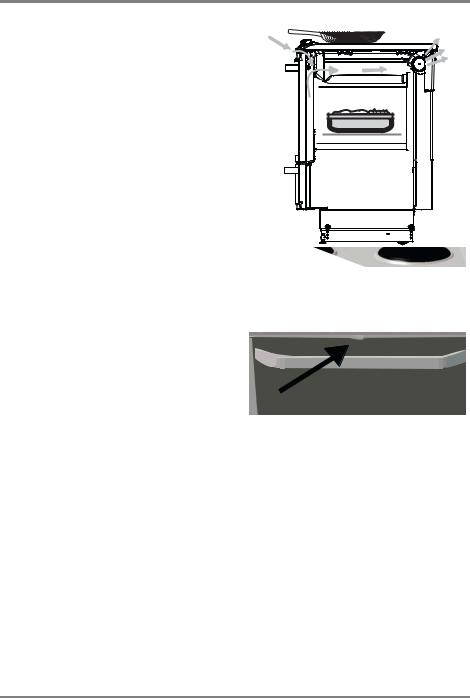
The cooling fan
The cooker is fitted with a cooling fan. The purpose of the fan is to keep the appliance cool.
The cooling fan starts automatically when the oven is used. When only the hob is used, the fan has a delayed start.
When the cooker is switched off, the fan stops automatically when oven temperature
has decreased to 120oC.
The door lock
The door lock makes it more difficult for children to open the door. The lock is engaged when the cooker is delivered, but can be disconnected as necessary.
TO OPEN THE DOOR
Move the lock to the right when you want to open the door.
DISCONNECTING THE LOCK
Check that the oven is not hot! Move the lock to the right, lift up and move it further slightly to the right, then lift the left-hand edge of the button.
CONNECTING THE LOCK
Move the lock to the right and down.
11
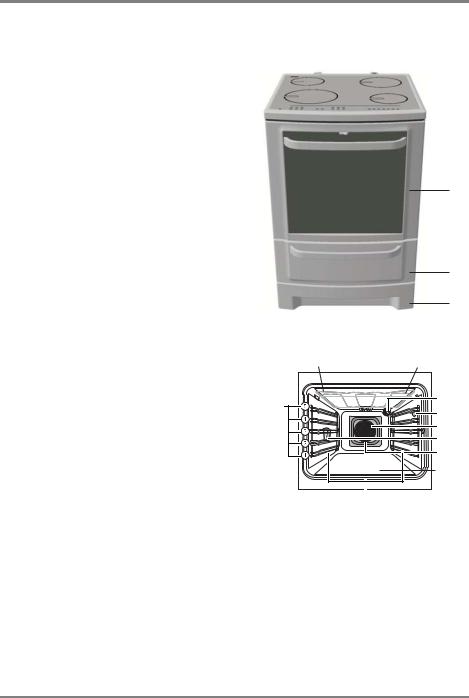
Description of product |
|
|
|
Cooker |
|
1 |
|
1 |
Ceramic hob |
|
|
|
2 |
||
2 |
Control panel |
|
|
|
|
||
3Oven
4Storage drawer
5Plinth
3
4
5
Oven
1Top heat element
2Heating element
3Oven lighting, 40W
4Meat probe socket
5Fan cover
6Oven lighting, 25W
7Fan heating element
8Bottom heat
9Oven shelf runners, removable
10Shelf positions
1 |
2 |
|
10 |
3 |
|
4 |
||
|
||
|
5 |
|
|
6 |
|
|
7 |
|
|
8 |
|
|
9 |
12
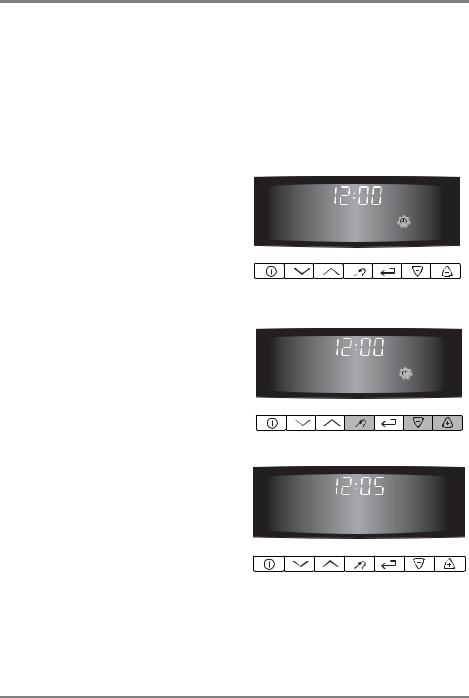
Before using for the first time
Setting the clock
When the power to the oven is connected, a
clock symbol  flashes until you have set the time on the clock.
flashes until you have set the time on the clock.
SET THE TIME LIKE THIS:
1 Press  or
or  to set the right time.
to set the right time.
2 To change time already set, press On/Off  . Then press until
. Then press until
flashes. tills
tills  Follow the instructions in alternative 1.
Follow the instructions in alternative 1.
After about 5 seconds the clock stops flashing and the time is shown in the display.
Now you can use the cooker.
The clock can only be changed if the child proof lock is not activated, none of the clock
functions Cooking time  or Stop time
or Stop time  or any other oven function is set.
or any other oven function is set.
13
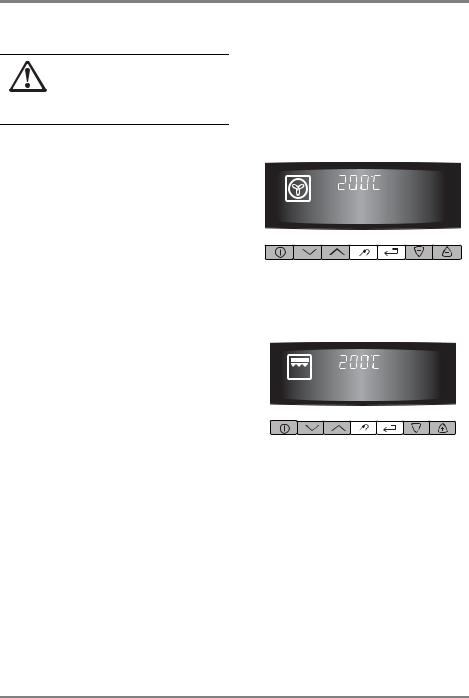
Heat the oven emty
Keep children under supervision! The cooker becomes very hot.
Do not forget to remove all packing material from inside the oven.
The oven must be burnt off before it is used for the first time. This is done as follows:
1Open the oven door and remove all the accessories from the oven cavity.
2Switch on the oven  . Select hot air
. Select hot air
 by using
by using  or
or  . Select a temperature of 200oC. The temperature can be changed by using
. Select a temperature of 200oC. The temperature can be changed by using
 and
and  . The oven door must be closed.
. The oven door must be closed.
3Leave the oven at this setting for about one hour.
4Move over to the Max. grill function
 by using
by using  or
or  . Select a temperature of 200oC. The temperature can be changed by using
. Select a temperature of 200oC. The temperature can be changed by using
 and
and  . The oven door must be closed.
. The oven door must be closed.
5Leave the oven at this setting for about 30 minutes.
6Switch off the cooker  .
.
7Then leave the oven door open for about two hours and air out the kitchen.
8Clean the oven, the door and the oven-step units with hot water and washing-up liquid. Dry the oven
The first time an oven is used, there may still be a slight smell. This will not affect the food in any way and is not a health-hazard.
Clean the accessories
Wash the shelves, roasting pan, etc. in hot water and washing-up liquid. Rinse and dry.
14
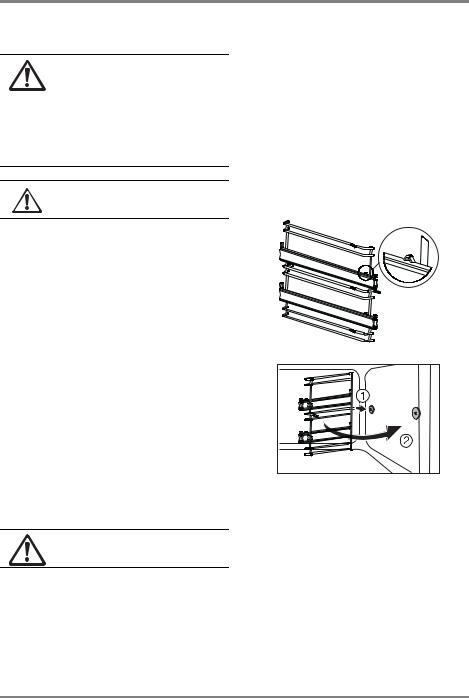
Telescopic runners
To prevent scratches during transport, the telescopic runners are covered with a protective coating when delivered. This coating must be removed from the runners before they are used, otherwise it can burn fast and damage the rails.
Note! Make sure that the cooker antitip guard is fitted, see page 8
The telescopic runners replace the ordinary oven step units that are fitted in the cooker when it is delivered. They consist of two rails that can be pulled out. The shelves, the roasting pan and the grid are laid on top of the rails. A locating pin keeps the shelf in position (see the illustration).
Use of the telescopic runners for facilitates cooking. For example, when steak or chips are to be basted, the roasting pan is easily pulled out on the rails.
Fitting the rails
First remove the oven step units that are fitted (see page 57). When fitting, the rails are first inserted in the inner hole (1) and then in the outer (2). Push into position.
MAKE SURE THAT THE LOCATING PIN IS
TURNED OUTWARDS TOWARDS THE OVEN DOOR.
The rails must be pushed in when the oven door is closed.
15
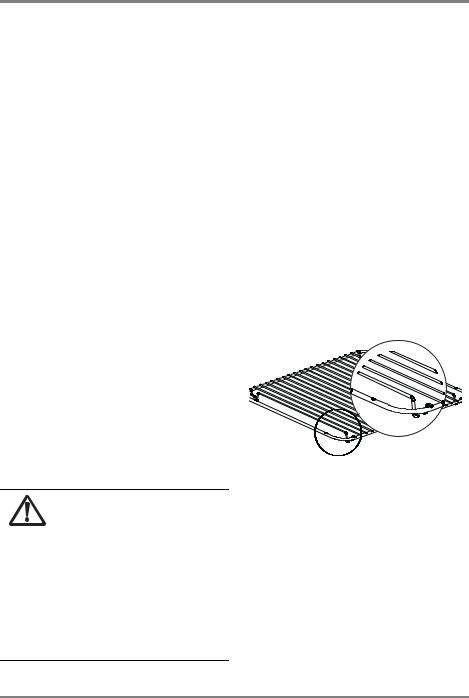
Using grids, baking plates and roasting pan
It is important for the oven grid, the shelves and the roasting pan to be fixed between the stops in the front and rear edges of the rails to prevent them from falling off the rails.
Place the baking plate/roasting pan/grid in the rear edge and fix against the front edge. The locating pin fits into a slot under the edge of the baking plate/roasting pan, which means that the baking plate/roasting pan is held in position.The rails must be in their pushed-in position when the grid/baking plate/roasting pan is inserted. For the best shelf stability, make sure that the bevelled edge is inwards in the oven. Pull the accessories carefully when using them so that the plate/pan/grid does not fall off the rails. Maximum load 20kg (44 lb.).
Using the oven grid
The locating pin is not needed when using the grid. The oven grid shelf has a mark on its upper surface. This marking must be at the front (towards the oven door) when in use. Make sure that food placed on the grid is positioned behind the marking. Otherwise there is a risk that it will not be cooked properly at the front. The grid can be placed in the roasting pan. The maximum weight to be placed on the grid is 10kg (22 lb.).
NOTE! Make sure that the locating pin hooks in under the baking plate edge/roasting pan and that the baking plate/roasting pan rests on the rails, otherwise it can fall off the rails in the pulled-out position. When the baking plate/roasting pan is removed in the pulled-out position, the rails must be pushed back again so that the oven door can be closed. Use oven gloves because the rails are hot.
16
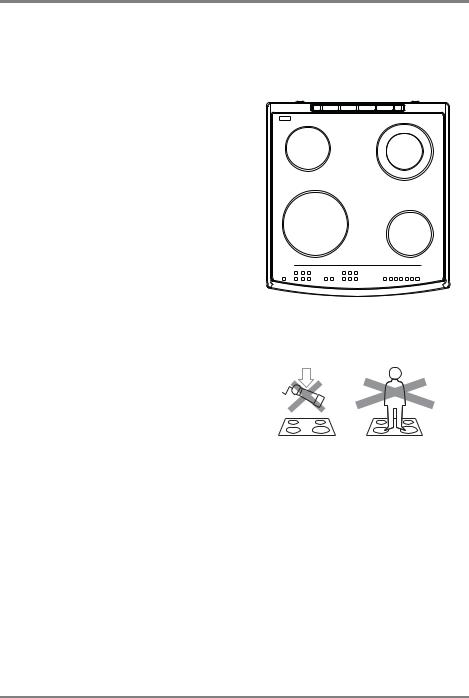
Using the ceramic hob
The hob can not be used if the oven is not switched on, see page 33.
The hob has four heating zones with:
•MIN./MAX. SIZE on the right rear zone.
•A SWIVEL WINDOW which provides
information about the zone.
•AUTOMAX, an automatic heater-
whereby the zone heats up rapidly to the heating level you need (for cooking/roasting) without it being necessary to change the knob setting.
•HEAT WARNER. When you have
switched off a zone, the swivel window lights up H as long as the zone is hotter than about 55°C.
•AUTOMATIC SWITCH-OFF after a time.
The higher the heating level, the earlier the zone is switched off.
The glass in the hob tolerates, heat, cold and temperature shocks, but is sensitive to impact. A spice jar or grinder falling onto the plate could crack it. Never use the hob to stand on, off-load materials onto or use as a storage area.
17

Never use a cracked plate or an oven with a cracked timer glass.
Liquids could, if they boil over, or during cleaning, penetrate down into the live electrical components. Turn off the power supply to the cooker and contact Service for repairs. Never lay metal objects such as lids, knives and spoons on the hob. They become hot if a heating zone is switched on by mistake.
Immediately after use (while the hob is still hot) clean with the blade scraper to remove sugar and spills with a high sugar content, such as marmalade, and also any melted plastic or foil, in order to avoid damage to the plate.
Never leave a deep fat fryer, melting fat, paraffin or other easily flammable substance unattended. In the event of fire, turn off the cooker knobs and switch off the cooling fan.
EXTINGUISH A FIRE WITH A POT LID, never use water.
Make sure that there is no sand, sugar or salt on pots and pans. Sand can cause scratches, while sugar and salt can ruin the ceramic glass plate. Always dry pots and pans before placing them on the ceramic glass plate. The coloured decor on the ceramic glass plate can become worn and scratched as it is used.
18

Changing zone size
MIN.
Press  for the cookingzone you want to use and choose the disered heating setting
for the cookingzone you want to use and choose the disered heating setting
with  or
or  .
.
MAX.
1Press for the cookingzone you want to use, the indication lamp for the doublezone function lights.
for the cookingzone you want to use, the indication lamp for the doublezone function lights.
2Choose desired setting between 1 and 9. After being zeroed, the zone automatically retains the setting latest used.
Safety switch-off of the cooking zones
If one of the cooking zones is not switched off after a certain time or the heating setting is not changed, the cooking zone concerned is switched off automatically.
Residual heating is shown by (“hot”) in the digital display for the cooking zone concerned.
(“hot”) in the digital display for the cooking zone concerned.
The cooking zones are switched off automatically in accordance with the following timetable:
•Setting ,
,  ,
, after 6 hours
after 6 hours
•Setting  ,
,  after 5 hours
after 5 hours
•Setting after 4 hours
after 4 hours
•Setting , ,
, , ,
, after 1.5 hours
after 1.5 hours
If one or more of the cooking zones should shut off before the expiration of the stated time, see the chapter “Problems and remedies”
19

Residual heat warner
After one or more heating zones have been switched off, the digital display shows the
residual heat 
 (“Hot”) for the respective cooking zone.
(“Hot”) for the respective cooking zone.
Even after the hob has been switched off, the display does not go out until the cooking zones have cooled down.
•The residual heat can be used to melt foodstuffs or to hold food warm.
•Important! There is risk of burns as long as the residual heat warner is alight.
•Important! In the event of a power
cut, the symbol 
 goes out and thereby the residual heat warning. There is still the rusk of burns. Burns can be avoided by being observant.
goes out and thereby the residual heat warning. There is still the rusk of burns. Burns can be avoided by being observant.
Choice of pan/frying pan
A cooker with a ceramic glass plate makes greater demands on your pots and pans that a cooker with heating plates. Remember the following:
•Check the bottoms of pots and pans. Pans with a convex bottom (bulging outwards) tend to swivel on the ceramic glass plate and provide poor heating contact.
•Aluminium has good heat conductivity, but can leave silvery marks on the plate.
•Casseroles and pans that are made of glass or are enamelled with deep patterns cause more wear if they are pulled backwards and forwards on the plate than pots and pans made of other materials.
20
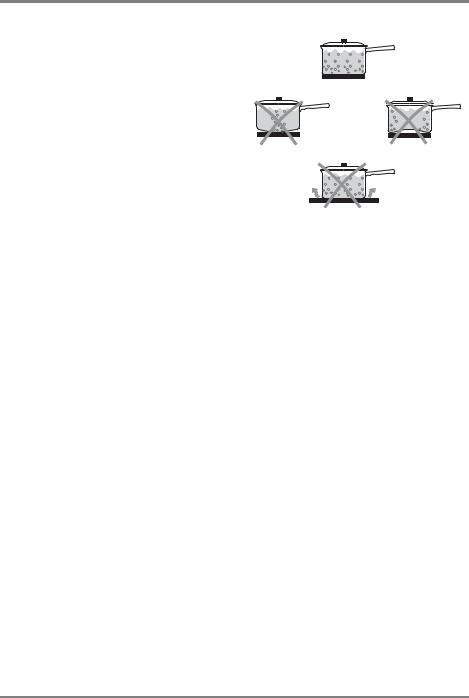
In order to save both time and energy the bottom of a pan or frying-pan
•must cover the zone completely. But if the bottom is too small, then boilover can easily stick to the plate.
•must be smooth or finely patterned.
•must be absolutely flat. If the bottom bulges too much outwards or inwards, heating-up times become longer.
When you buy new pans, it is advisable to choose a stainless steel model with a sandwich-bottom, that is to say a bottom with layers of different metals. Certain pans are concave when cold but become flat when they are heated up.
21
